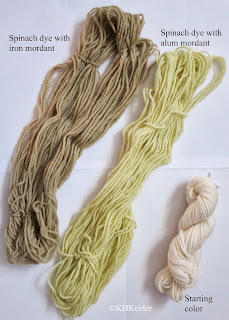 |
| Naturally-dyed yarns |
I love color. I have knitted and woven and embroidered since I was very small. Trying plant-based dyes was an obvious intersection of my interests. Plants! Color! Wonderful!
So off and on I will write about dye plants, even though most of the important dye plants are unknown to most people.
But dyes from plant sources are familiar. The grass stain you got on you jeans sliding into first in the neighborhood softball game? That's a basic dye found in most leaves. Leaves of many plants will produce a yellow or olive green dye.
 |
Spinach as a dye;
package of frozen spinach
in water
The mesh bag keeps spinach
bits out of the yarn |
Cheryl Stuchl, who got me started, said "if you can cook spinach, you can dye." Indeed, spinach (Spinacia oleracea) makes a good yellow and olive. You put a package of spinach, fresh or frozen, in a saucepan of water and simmer until the water is quite green. That's your dyebath.
Natural dyeing is a skill because you can't just pour the dyebath over cloth and get a satisfactory result.
 |
| Remove spinach |
First most natural dyes will not stick to cloth on their own. A mordant is required. Mordants are metal ions that link the colored dye molecule to the fiber. Mordants also influence the color produced.
 |
| Look! Spinach dye. |
Second, even with a mordant, not all fibers take up color well. Synthetics are usually a waste of your time. Cottons change color but getting more than weak "pastel" shades requires several steps. However, wool and silk readily dye to intense long-lasting colors. (However, by the time they are sewn into clothes, fibers have been treated with a number of compounds. To get good dye results, start with yarns or cloth intended for home dyeing or wash your garments rigorously.)
 |
| Yarn dyeing |
To use my spinach dye, I tossed a teaspoon alum into the pot, dissolved it, added yarn, about 25 g skein of wet wool, and heated it, without boiling, for 1 hour.
This is my "you can do this! " version of the recipe. Careful workers measure 10% alum to WOG (weight of goods), dry weight of alum to dry weight of things being dyed.
Here's the principle: Getting the fiber to change color in natural dyeing is easy. Getting it to change to a particular color can be very difficult. Precise measurements help.
Alum is any of several aluminum salts-- dyeing needs the aluminum molecule not whatever salt is attached to it. Grocery stores used to sell it for pickling, today you might ask the pharmacy department, look in a hobby supply store, or shop dye suppliers online.
The spinach bath with alum should give you a nice bright yellow yarn. Rinse thoroughly.
Prudent dyers have pans and spoons that are used only for dyeing. Spinach juice won't hurt anyone and a teaspoon of alum, while it should not be eaten, is not very toxic dissolved in 2 quarts of water, but the next dye plant might not be safe. Use designated pots and spoons.
 |
| colors from spinach |
I mentioned getting olive shades from leaves. To do that you change mordants. Iron saddens (technical term!) dyes. In the case of yellows it turns them olive. To make an iron mordant solution at home, soak rusty nails a couple days in vinegar. I added a small amount--a teaspoon--to the spinach dye bath, alum and all, stirred and added a 25 g skein of wet wool. Then I simmered it for one hour. Too much iron makes wool feel brittle and wear out much faster, so less is better.
One package of spinach and you get yellow and olive-green yarn. Or silk scarves. More spinach will put more dye in the water and produce darker colors. So will longer periods heating or soaking the yarn. See Sheron Rowland's blog for more details: dyeing with fresh plants
 |
| apple tree |
These are reasonably fast colors. They don't fade much from sunlight. Washed with hand-wash soaps the colors won't wash out. Detergents, however, strip mordant and dye off the cloth as if they were stains: do not wash naturally dyed cloth in detergent!
Lots of other plants work like spinach: leaves of apple (Malus, specifics in Sheron's blog ), aspen and cottonwood (Populus spp.), dock (Rumex), willow (Salix), field bindweed (Convolvulus arvensis) (see Sheron's blog on bindweed), rabbitbrush (Ericameria nauseous), to name just a few.
 |
| aspen |
I haven't gotten much dye from lettuce or green cabbage. Red cabbage has a whole different set of dye molecules and is a story for another day.
 |
| rabbitbrush |
 |
| weld |
Traditional European dyers used weld (Reseda luteola), dyers' mulberry (Maclura tinctura), dyers' greenweed (Genista tinctoria), dyers' safflower (Carthamnus tinctura), saffron (Crocus sativus), and others. More about those another day too.
In 1856 English chemist William Henry Perkin stumbled on the first aniline dye and all these natiral dyes became obsolete almost over night. The aniline dyes were readily produced in large quantities for very low prices. They revolutionized color--everyone could now afford bright colored clothes and accessories.
Dyeing with local plants is a tradition that before 1850 goes back millennia in virtually every culture. It is great fun!
Comments and corrections welcome.
Thank you, Sheron of Foxryde Gardens, for hosting the "if you can cook spinach you can dye" demo.
Kathy Keeler, A Wandering Botanist










Nice blog and very helpful.
ReplyDeleteI was going to cook some spinach from the garden, left it too long in the pot when noticed the dye so I thought to dye some of my sheep fleece with it.
Will do so now I've read your blog.
Thanks